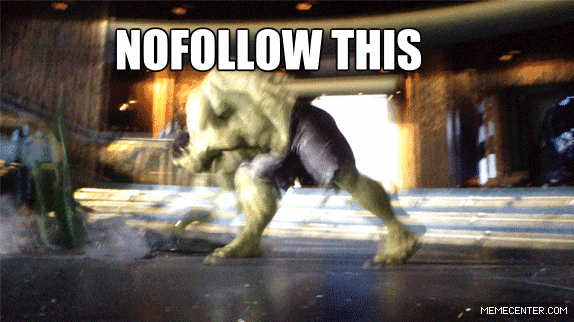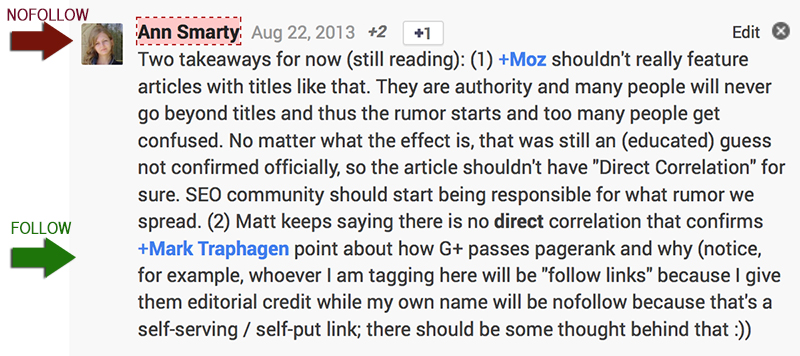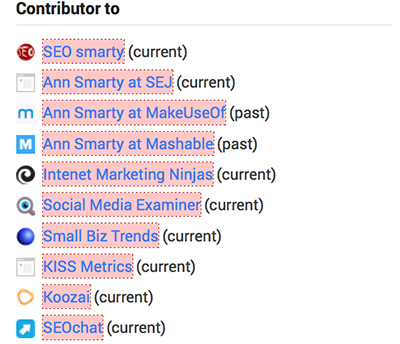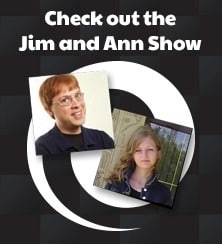
I can’t believe the official Google’s page sounds so misleading:
In general, we don’t follow them. This means that Google does not transfer PageRank or anchor text across these links. Essentially, using nofollow causes us to drop the target links from our overall graph of the web
[So this sounds much like they seem to be saying: “Our search bot may go to that nofollowed page but no link juice / anchor text will be passed”]
However if you keep reading, they seem to be saying that Google won’t even find the page unless there are non-nofollow links to it:
However, the target pages may still appear in our index if other sites link to them without using nofollow, or if the URLs are submitted to Google in a Sitemap.
Ok, this is not exactly true…
Let’s sum up what we know and think we know about nofollow attribute:
- Are nofollowed links *completely* ignored by Google? (hint: not exactly)
- Does internal nofollow links make sense? (hint: on rare cases, yes but not for “PageRank” sculpting)
- Does rel=”nofollow” prevents Google Authorship to be assigned? (hint: It seems it doesn’t)
- So when to use rel=”nofollow”? (hint: I am too humble to give straightforward advice but I can list official rules to keep everyone sane)
- Should I Disavow nofollowed links? (hint: Nope)
Tests prove: Nofollow Links Are Used for Discovery
No matter how misleading the official page sounds, numerous tests have proven that nofollow links are used for discovery (Google finds and crawls the page that has only one nofollow link)
A couple of tests also showed that nofollow links may be affecting rankings as well, but I’ve never been able to go that far in my own experiments.
Official: Google Leaks PageRank While not Rewarding it
With the introduction of nofollow as the way to link while not passing link juice, SEOs quickly understood they could use it to their advantage. Now they had the way to control how link juice flows within the site.
Google’s response came in 2009 when Matt said using internal nofollow is basically useless because they leak PageRank anyway. The vague explanation was “With or without nofollow, Google is smart enough to understand which link should leak link juice” (e.g. it should be smart enough not to “leak” link juice through nofollow comment links while still leaking it to nofollowed “About us” page).
Even with such a vague explanation many people were happy with the change: No more insane “PageRank” sculpting guides and howtos. Internal nofollow is now officially useless.
**Note how Google Plus is using nofollow attribute for sculpting internal citation flow.
Fact: Nofollow Passes Google Authorship
Even if you leave your Google Plus link nofollow, Google will be able to go and grab your photo and circles to verify your authorship.
And Google is obviously OK with following your nofollow links in “Contributor to” section.
So… What’s the Best Way to Use Nofollow? Should I Use it At All?
It’s basically up to you. Officially Google recommends using nofollow attribute for one of the below cases:
- For user-generated content (Which is up to you as it depends on how hard you moderate your UGC).
- For paid links (Basically, if you sell ads on your site, you probably want to be on the safe side)
- To stop Google from following links to pages behind logins (Simply because Google bot won’t be able to access that page, so save the bot from even trying. The bot’s time is valuable :))
**Note, Google’s official nofollow guidelines don’t mention nofollowing links if you decide to link to your other article or blog or other insane cases that keep being discussed around the web.
Should I Disavow rel=”Nofollow” Links
I can’t believe how often I hear that question..
While Matt Cutts vaguely mentions that nofollow links may cause manual penalty and nofollow links appeared as samples of “bad links” in GWT, disavowing nofollow links simply doesn’t make sense, as Disavow simply tells Google to nofollow them, so that would be double nofollow 🙂
I hope this clears some confusion!






90 Responses
‘Rel=”Nofollow”: Summing up What We Know’ by @NinjasMarketing http://t.co/bVggKVd4hW
‘Rel=”Nofollow”: Summing up What We Know’ by @NinjasMarketing http://t.co/v3klf8OK5y
‘Rel=”Nofollow”: Summing up What We Know’ by @NinjasMarketing http://t.co/u4ntb7kE2I
‘Rel=”Nofollow”: Summing up What We Know’ by @NinjasMarketing http://t.co/jng4bSNSX8
‘Rel=”Nofollow”: Summing up What We Know’ by @NinjasMarketing http://t.co/oY0A5H8jMY
‘Rel=”Nofollow”: Summing up What We Know’ by @NinjasMarketing http://t.co/f5sZUyyyhe
‘Rel=”Nofollow”: Summing up What We Know’ by @NinjasMarketing http://t.co/mGZr4v31cm
Rel=”Nofollow”: Summing up What We Know http://t.co/FPIeZcy53K http://t.co/mnqtlrNGk1
RT @DevSEOChat: ‘Rel=”Nofollow”: Summing up What We Know’ by @NinjasMarketing http://t.co/zh9QFPTzRD
‘Rel=”Nofollow”: Summing up What We Know’ by @NinjasMarketing http://t.co/6l9wrdXMX5
“@seosmarty: ‘Rel=”Nofollow”: Summing up What We Know’ by @NinjasMarketing http://t.co/wd89YM0wp0”
Rel=”Nofollow”: Summing up What We Know http://t.co/PstEJiMSL5
Rel=”Nofollow”: Summing up What We Know http://t.co/0XQLavK91M #SEO #SEOBEES
Well now I am really confused. Well follow links pass link juice and no follow dosen’t. But there are many theories say that “Hey no-follow still passes some link juice like 50% or may be 5%”
But again no-follow stopped many marketers to spam comments. I believe that the best way to judge no-follow that whether is passes link juice needs to be experimented.
Rel=”Nofollow”: Summing up What We Know http://t.co/81Bu82t07c #harrogateseo
Rel=”Nofollow”: Summing up What We Know http://t.co/kWhYM7YIyn Fantastic summary post by @SEOSmarty
Rel=”Nofollow”: Summing up What We Know http://t.co/GpaISMWSQZ
RT @ChadW8: Rel=”Nofollow”: Summing up What We Know http://t.co/kWhYM7YIyn Fantastic summary post by @SEOSmarty
Rel=”Nofollow”: Summing up What We Know – http://t.co/nXhyvoCper
RT @woorank: Rel=”Nofollow”: Summing up What We Know – http://t.co/nXhyvoCper
‘Rel=”Nofollow”: Summing up What We Know’ by @NinjasMarketing http://t.co/L1vqTq7NVB
Rel=”Nofollow”: Summing up What We Know by @NinjasMarketing http://t.co/htjrcX5ZWs
Rel=”Nofollow”: Summing up What We Know http://t.co/VDvELs8aqy
Rel=”Nofollow”: Summing up What We Know http://t.co/dknLN0znNr via @ninjasmarketing by @seosmarty
RT @kikolani: Rel=”Nofollow”: Summing up What We Know http://t.co/dknLN0znNr via @ninjasmarketing by @seosmarty
RT @seosmarty: ‘Rel=”Nofollow”: Summing up What We Know’ by @NinjasMarketing http://t.co/hDekmU3DjD
Rel=”Nofollow”: Summing up What We Know
http://t.co/az2pDZAdvY
#SEO via @NinjasMarketing @seosmarty
Rel=”Nofollow”: Summing up What We Know /by @seosmarty via @ninjasmarketing http://t.co/tIYR6EPi8G #nofollow #links
‘Rel=”Nofollow”: Summing up What We Know’ by @NinjasMarketing http://t.co/TPGjUPsShC
Makes sense really. We know that Google will penalise a site for linking to bad places. We know that Google will penalise a site for being a doorway / bridge page or general affiliate spammer. So no surprise that they will follow links sometimes to see what you are linking to. It would be foolish of Google to simply ignore where your links go and foolish of you to link to bad neighbourhoods and think you can hide behind “nofollow”.
‘Rel=”Nofollow”: Summing up What We Know’ by @NinjasMarketing http://t.co/dkPDodiUj8 #SEO
‘Rel=”Nofollow”: Summing up What We Know’ by @NinjasMarketing http://t.co/Ax7FC6Sz99
Rel=”Nofollow”: Summing up What We Know – http://t.co/MF9FOwDoXI
Rel=”Nofollow”: Summing up What We Know – Yes, rel=”nofollow” is old news but that doesn’t mean it has sto… http://t.co/XLDjav42tL
RT @NinjasMarketing: Rel=”Nofollow”: Summing up What We Know http://t.co/lXxPhti69o
RT @NinjasMarketing: Rel=”Nofollow”: Summing up What We Know http://t.co/lXxPhti69o
What I find funniest about the no-follow thing is that only web-savvy people use it. Any lay person who has a blog to share what he things, writes or photographs does not even know what we are talking about.
In my humble opinion, the nofollow is a waste of time. It was not part of the HTML4 web standard for . It is part of the HTML5 standard, but, in my opinion, it is not really useful.
The Internet became what it became because of links. The idea of having “links which should not be considered as links” is a bit contradictory, not to say stupid.
Errata:
Where you can read:
“HTML4 web standard for .”
It should say:
In my humble opinion, the nofollow is a waste of time. It was not part of the HTML4 web standard for <agt;.
Almost forgotten but still important: rel=”nofollow”. Sum up of what to know by @seosmarty http://t.co/5kOOg2dPVl
“Rel=”Nofollow”: Summing up What We Know” http://t.co/pINM8Dht0e
‘Rel=”Nofollow”: Summing up What We Know’ by @NinjasMarketing http://t.co/bbZtFTxkOg
RT @MaikBruns: Almost forgotten but still important: rel=”nofollow”. Sum up of what to know by @seosmarty http://t.co/5kOOg2dPVl
RT @MaikBruns: Almost forgotten but still important: rel=”nofollow”. Sum up of what to know by @seosmarty http://t.co/5kOOg2dPVl
RT @MaikBruns: Almost forgotten but still important: rel=”nofollow”. Sum up of what to know by @seosmarty http://t.co/5kOOg2dPVl
‘Rel=”Nofollow”: Summing up What We Know’ by @seosmarty via @NinjasMarketing http://t.co/dYA6Piq35S nice round up
Rel=”Nofollow”: Summing up What We Know
http://t.co/YBoRbuliRb #linkbuilding #seo #sem
RT @link_sphinx: Rel=”Nofollow”: Summing up What We Know
http://t.co/YBoRbuliRb #linkbuilding #seo #sem
Note how Google Plus is using nofollow attribute for sculpting internal citation flow http://t.co/f1VSCh5bA6
Graphic Art liked this on Facebook.
‘Rel=”Nofollow”: Summing up What We Know’ by @seosmarty http://t.co/SyGevv1Krb
RT @link_sphinx: Rel=”Nofollow”: Summing up What We Know
http://t.co/YBoRbuliRb #linkbuilding #seo #sem
Rel=”#Nofollow”: Summing up What We Know http://t.co/qh2zCzkPEk. #seo
RT @VictorHCordero: Rel=”#Nofollow”: Summing up What We Know http://t.co/qh2zCzkPEk. #seo
‘Rel=”Nofollow”: Summing up What We Know’ by @NinjasMarketing http://t.co/TK2hbL7wiJ
RT @MaikBruns: Almost forgotten but still important: rel=”nofollow”. Sum up of what to know by @seosmarty http://t.co/Qoek7FkK4p
‘Rel=”Nofollow”: Summing up What We Know’ by @NinjasMarketing http://t.co/2c3rXPPLqc RT @seosmarty
Qué hacer con el “No Follow”??? // ‘Rel=”Nofollow”: Summing up What We Know’ by @NinjasMarketing http://t.co/NH1kwYsL0r
‘Rel=”Nofollow”: Summing up What We Know’ by @NinjasMarketing http://t.co/YU7V2ZXEk9
‘Rel=”Nofollow”: Summing up What We Know’ by @NinjasMarketing http://t.co/yYcLoJM3FD
Rel=”Nofollow”: Summing up What We Know http://t.co/OZrZIkf843 #SEO
RT @sergio_redondo: Rel=”Nofollow”: Summing up What We Know http://t.co/OZrZIkf843 #SEO
When i was start to apply rel=”nofollow” on one of my BIG page since 1-2 years back, i could see my own pagerank was growing. So i am indeed very confuing what everybody talk about .
Tedel, I disagree that only web savvy people use nofollow. I think a great many people use it *incorrectly* simply because they read it somewhere, or someone told them about it. Which in my mind, does not make them web savvy 😀
I also say forget the link juice, there is no such thing anymore. Nor does page rank matter even make a website a “quality” site.
Write for *readers* and not for SEO. Make your content interesting, valuable and therefore sociable. That’s what matters more than all the rest.
Rel=”Nofollow”: Summing up What We Know http://t.co/L1vqTq7NVB by @annsmarty via @NinjasMarketing
Opět trocha polemizace nad současným stavem rel=”nofollow”. Pěkně sepsáno:
http://t.co/8jIycxUmLm
od @NinjasMarketing
RT @LdyLarke: Rel=”Nofollow”: Summing up What We Know http://t.co/L1vqTq7NVB by @annsmarty via @NinjasMarketing
Rel=”Nofollow”: Summing up What We Know http://t.co/g75YNfJxUX
‘Rel=”Nofollow”: Summing up What We Know’ by @NinjasMarketing http://t.co/Ji8p11M6Mv
Článek od Ann Smarty shrnuje dosavadní stav používání parametru “nofollow” .http://t.co/1EEv8cZvLj
RT @filippodstavec: Opět trocha polemizace nad současným stavem rel=”nofollow”. Pěkně sepsáno:
http://t.co/8jIycxUmLm
od @NinjasMarketing
RT @LdyLarke: Rel=”Nofollow”: Summing up What We Know http://t.co/L1vqTq7NVB by @annsmarty via @NinjasMarketing
Rel=”Nofollow”: Summing up What We Know http://t.co/qqklv5bw7t
RT @cognitiveSEO: Rel=”Nofollow”: Summing up What We Know http://t.co/g75YNfJxUX
Le point sur le nofollow http://t.co/mHgduWa9d0 #nofollow #seo #referencement
RT @renaudjoly: Le point sur le nofollow http://t.co/mHgduWa9d0 #nofollow #seo #referencement
RT @renaudjoly: Le point sur le nofollow http://t.co/mHgduWa9d0 #nofollow #seo #referencement
‘Rel=”Nofollow”: Summing up What We Know’ by @NinjasMarketing http://t.co/LtylmHiqgH
RT @renaudjoly: Le point sur le nofollow http://t.co/mHgduWa9d0 #nofollow #seo #referencement
RT @renaudjoly: Le point sur le nofollow http://t.co/mHgduWa9d0 #nofollow #seo #referencement
http://t.co/OFUxZLW2ut
Brilliant top gif there: http://t.co/li0BvHCEWL
Rel=”Nofollow”: Summing up What We Know via @aaronwall: Yes, rel=”nofollow” is old news but that doesn’t mean it… http://t.co/hSwWmfmlTp
Rel=”Nofollow”: Summing up What We Know http://t.co/euLyUVchHH #SEO @ninjasmarketing
Rel=”Nofollow”: Summing up What We Know http://t.co/xNVYuMl0M0
RT @OfSocialMedia: Rel=”Nofollow”: Summing up What We Know http://t.co/xNVYuMl0M0
‘Rel=”Nofollow”: Summing up What We Know’ by @NinjasMarketing http://t.co/GnpA6gHhPO
‘Rel=”Nofollow”: Summing up What We Know’ by @NinjasMarketing http://t.co/67tugjBM62
Sammlung aller bekannter Fakten zu rel=”nofollow” http://t.co/r5k6ggtmsy
RT @MalteLandwehr: Sammlung aller bekannter Fakten zu rel=”nofollow” http://t.co/r5k6ggtmsy
RT @MalteLandwehr: Sammlung aller bekannter Fakten zu rel=”nofollow” http://t.co/r5k6ggtmsy
Comments are closed.